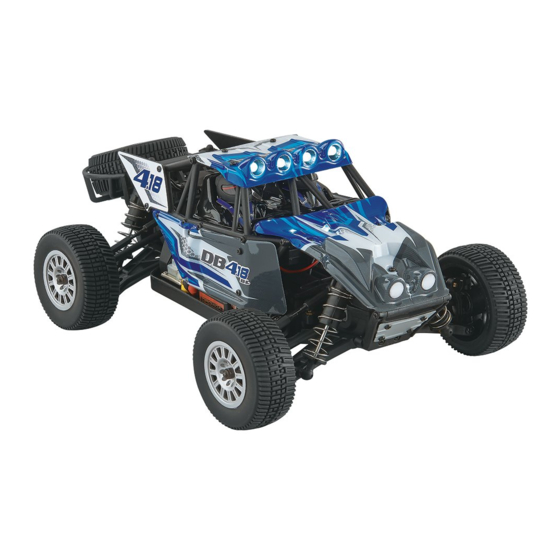- ページ 12
電動おもちゃの車 Dromida DB 4.18のPDF 組立・メンテナンスマニュアルをオンラインで閲覧またはダウンロードできます。Dromida DB 4.18 13 ページ。 Radio controlled truck
Dromida DB 4.18 にも: オーナーズマニュアル (4 ページ)

TUNING GUIDE
When tuning the Dromida DB4.18 make sure that you have equal lengths from one side to the other on the shocks
and upper rods. Also, make sure to have the shock pre-load adjusters at the same setting from left to right. They
do not have to be the same front to rear.
PINIONS
The Dromida DB4.18 comes stock with the 12 tooth pinion. To obtain higher top speeds you can install a larger
pinion gear onto the motor. This will, however, decrease your acceleration and run time. TIP: Smaller pinion equals
more torque, less top speed. Larger pinion equals more top speed, less torque.
SHOCK OIL
The Dromida DB4.18 comes stock with 30 weight oil in the shocks. The handling can be tuned by changing the
shock oil to either heavier (bigger number) or lighter (smaller number). By putting heavier oil in the shocks, the
car will have less chassis roll and become more responsive. Putting lighter oil in the shocks will cause the car to
be less responsive and have more chassis roll. For smooth, high traction surfaces, a thicker oil would be best. For
low traction or bumpy surfaces, a lighter oil would be best.
CAMBER
2˚ NEGATIVE CAMBER
Camber refers to the angle at which the tire and wheel ride
in relation to the ground when viewed from the front or rear.
Negative camber is when the wheels lean inward and positive
camber is when the wheels lean outward. Usually adding
a small amount of negative camber (0° to -2°) will increase
traction. However, adding too much camber will decrease
ADJUST LENGTH TO
traction. The objective is to keep as much of the tire as possible
CHANGE THE CAMBER
in contact with the running surface. Never put in positive
camber. Make sure that both sides are equal.
SHOCK SPRINGS
For low traction or bumpy surfaces, a softer spring should be used. For high traction or smooth surfaces, a firmer
spring should be used.
FRONT SHOCK ADJUSTMENT
Moving the tops of the shocks out (A) will increase steering
reaction but decrease front traction. Moving the tops of the
A
A
B
B
shocks in (B) will result in slower steering reaction but will be
smoother over bumps and have more front traction.
REAR SHOCK ADJUSTMENT
A
Moving the tops of the shocks out (A) will increase steering
reaction and decrease rear traction. Moving the tops of the
shocks in (B) will result in slower steering reaction but will be
smoother over bumps and have more rear traction.
dromida.com
DIDC0045 v1.0 © 2014 DROMIDA, A HOBBICO COMPANY
We try very hard to have accurate and up-to-date information in this document. Any errors are unintentional.
